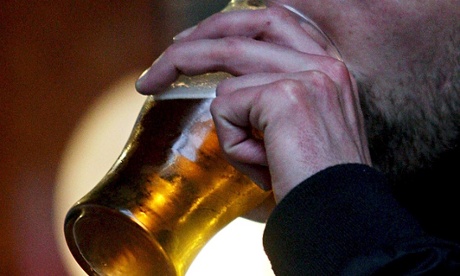Alcohol kills three Victorians and is a factor in 18 assaults and 81 hospital admissions every day, study shows

Alcohol is killing three Victorians every day, new data shows, with public health experts blaming the escalating problem on political inaction.
Alcohol was also responsible for 18 assaults and 81 hospital admissions across the state daily, the study released on Thursday found.
Ambulances were called to more than 8,300 alcohol-related incidents in 2011, an increase of 146% on figures a decade earlier.
In the decade from 2001-02 to 2010-11, alcohol-related hospital admissions rose by more than 50% to 29,694, while assaults involving alcohol increased 30% to 6,768.
The findings came from the Foundation for Alcohol Research and Education (Fare), which analysed data provided by the Victorian Police, the Australian Institute of Health and Welfare and the Turning Point alcohol and drug centre.
The chief executive of Fare, Michael Thorn, said he was disappointed neither the Coalition nor Labor had made alcohol reform a state election issue.
Both governments had made announcements about how to tackle illicit drugs such as ice, he said, but had neglected to promise action on alcohol, which caused much greater harm.
The Coalition had also taken action to address domestic violence, but much of that was being fuelled by alcohol, Thorn said.
“It makes me angry, this strategic decision by the political parties to step around the problem of alcohol,” he said. “When you look at the latest available numbers, there were 638 hospitalisations for stimulant misuse in Victoria in 2010-11, compared with almost 29,700 for alcohol.
“We deserve more from our leaders who must commit to tackling a problem as huge as this.
“Victoria is not being overwhelmed by ice, but by alcohol.”
Thorn said the federal government also had a responsibility to act, but state governments had contributed to alcohol-related harms in a “significant way” by increasing the number of liquor outlets and extending trading hours.
There are almost 20,000 active liquor licences in Victoria, up more than 20% since 2003-04.
“We don’t want to end up in a situation like NSW, where it takes the deaths of people like Daniel Christie or Thomas Kelly for the government to act by restricting trading hours,” Thorn said.
Guardian Australia has contacted the offices of the premier, Denis Napthine, and the opposition leader, Daniel Andrews, as well as the health and shadow health ministers, for comment.
Professor Mike Daube, president of the McCusker Centre for Action on Alcohol and Youth, said state and federal governments knew what needed to be done to curb alcohol-related harms.
But unlike the illicit ice market, alcohol had a powerful industry lobby to back it, which provided funding to most parties, Daube said.
“Of course we want to see action on ice,” he said. “But the harms of alcohol are massive and much greater, and the alcohol industry is much more powerful.
“Tackling ice is populist, to some extent it’s a distraction from the key issues, and unlike alcohol, ice isn’t being sold through large retailers like Coles and Woolworths who hold a 60% share of the alcohol market.
“So what we have is a very powerful alcohol lobby for retailers and hotels and, by and large, all parties are frightened of them and all parties take donations from those industries.”
Daube said measures that had proved to be effective in curbing alcohol-related harm included: reforming alcohol pricing and placing a volumetric tax on alcohol; restricting promotion; reforming labelling; and reforming trading hours and liquor licensing laws.
Dr Michael Livingston, from Fare’s centre for alcohol policy research, said research had shown the number of alcohol outlets and its increasing affordability were driving the high level of alcohol harm in Victoria.
“Studies tell us that as alcohol’s availability increases, so too do alcohol harms,” he said. “And unfortunately, as escalating harms data attests, Victoria is no exception to that rule.”
